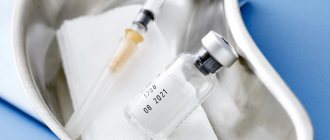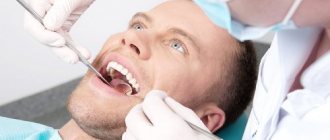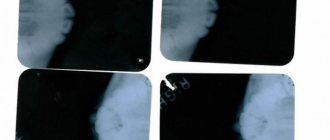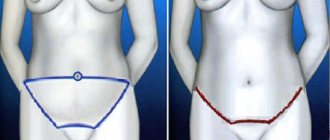Breast milk provides the baby with complete nutrition and all the beneficial substances and microelements the body needs, improves its immunity and promotes development. But breastfeeding is also a way of communication; it helps to establish a strong bond between mother and baby, expressing love and tenderness.
Taking care of the baby, many mothers who have enlarged their breasts with implants refuse breastfeeding for fear of harming the baby. And it’s completely in vain, because the question “is it possible to breastfeed with implants” has long been resolved - it has been established for certain that lactation after mammoplasty is possible and completely safe.
When can you get pregnant after plastic surgery?
After surgery (we are talking about aesthetic surgery, not extensive reconstructive surgery), it is recommended not to become pregnant for at least six months. Most often this question is addressed to surgeons specializing in mammoplasty, abdominoplasty and labiaplasty (correction of intimate organs).
To answer this question, you should look at the numbers, for example, the period of breast recovery after mammoplasty takes 6 months. Consequently, even if conception occurs immediately after its completion, the period between the operation and childbirth will take about 15 months. This period is quite enough to restore the body before childbirth. Based on consultations with specialists, the safe pregnancy period for each plastic surgery can be calculated in a similar way.
How safe is it to breastfeed with implants?
Lactation after breast augmentation is absolutely safe for a number of reasons. Let's look at this issue in more detail using the Motiva breast implants as an example:
- The shell of endoprostheses is made of a very thin but durable material that can withstand up to 20 tons of external load. It does not tear or deform, and the risk of damage is only 1%.
- The soft gel filler Progressive Gel Plus is dense and elastic, retains its shape and if the shell is damaged in emergency situations, it does not leak out, but remains in place. Even if the implant ruptures, its internal contents do not come into contact with the breast tissue.
- The implant gel filler is non-toxic, does not contain potentially harmful chemical or synthetic components, and does not dissolve in milk or other liquids. It is completely safe for both the child and the mother herself.
- An additional protective layer of bluseal prevents the gel from leaking through the shell and entering the body tissues.
- When breast augmentation occurs, implants are placed either under the mammary gland or under the pectoral muscle. Thus, they do not block the ducts of the mammary gland or interfere with the production or movement of milk.
The question of whether it is possible to breastfeed with implants, with the current level of technology and materials, has become irrelevant. And dear ladies who have undergone mammoplasty do not need to deny themselves anything at all, especially in such an important and necessary matter as feeding a child.
Plastic surgery after childbirth
Carrying out plastic surgery to normalize the aesthetics and health of the patient’s body also involves some recovery period after childbirth. Doctors advise performing operations of this type no earlier than six months later. Below you can see some of the results of plastic surgery.
Body liposculpture performed six months after childbirth.
Body liposculpture performed 7 months after birth.
Vaser liposuction abdominoplasty without navel transfer, performed 10 months after birth.
Body Liposuction Liposuction is a plastic surgery procedure that involves surgically removing fat deposits. Liposuction can be performed with or without various equipment, using the old mechanical method.
Breast lipofilling Breast lipofilling is a modern operation that allows you to increase the size of the mammary glands by using the patient’s own fat tissue.
Breast augmentation Breast enlargement surgeries are one of the most popular and sought-after plastic procedures aimed at increasing volume.
How implants affect the breastfeeding process
Long-term studies have established that the presence of breast implants in a mother does not in any way affect the lactation process and does not affect the quantity or quality of milk.
The feeding process itself is also no different from natural breastfeeding. It is enough for mom to follow the usual daily routine and diet recommended by the obstetrician upon discharge from the maternity hospital.
Modern implants are made from safe, clinically tested materials that perfectly imitate the texture and density of natural breast tissue. To the touch they are indistinguishable from real breasts - just as soft and elastic.
Implants do not interfere with the movement of milk through the milk ducts and do not impede its production. Therefore, the baby will not have to make additional efforts to eat, and the woman will not experience discomfort or pain when feeding.
Breast augmentation for nulliparous girls: features
Many surgeons are of the opinion that it is optimal (both in terms of costs and health burden) to resort to endoprosthetics after the birth of the last planned child. During pregnancy and lactation, not only mechanical, but also hormonal effects on the organ occur. There is no guarantee that it will retain its original aesthetics. Of course, nothing prevents a woman from adjusting her bust again in the future. But during the first surgical intervention, the risk of loss of nipple sensitivity and the formation of scar deformities is minimal, and with repeated operations it increases.
However, the experience of several generations has shown that breast augmentation before childbirth is widely practiced by women around the world.
Contraindications to mammoplasty
COVID-19✓ Safe
Of course, beautiful breasts are the main advantage and adornment of any woman. Whatever one may say, first of all men look at the breasts, because this is the very essence of femininity, beauty and attractiveness. Recent studies conducted by specialists from the University of California San Francisco (USA) have proven that only every tenth woman out of ten respondents is satisfied with the shape and size of her breasts and would not want to change anything. However, the point is not always and not only about the aesthetic effect - sometimes women resort to reconstructive mammoplasty after undergoing sectoral resection or mastectomy as a result of some disease of the mammary glands.
Every woman who decides to undergo mammoplasty surgery must remember that, regardless of the amount of work that the surgeon has to do - whether you decide to correct the shape of the nipple, slightly tighten the contour or install implants - any mammoplasty operation is a rather serious surgical intervention . That is why every woman should be aware of the extent of examination she will have to undergo before the planned operation, what indications and contraindications exist, as well as the types and methods used by the surgeon.
INDICATIONS FOR MAMMOPlasty
Mostly, women decide to undergo mammoplasty, of course, wanting to achieve an aesthetic effect - to increase breast size, make breasts more proportional to the body, restore breast shape after pregnancy or sudden weight loss, restore breast shape after removal of a breast tumor.
Mammoplasty is recommended for women who have an abnormal position of the nipple or areola, or inverted nipples that make feeding difficult. It becomes difficult for the baby to latch onto the nipple during lactation and a significant part of the mother’s precious milk simply does not enter the baby’s mouth, so in this case, mammoplasty, among other things, can indirectly help in the normal development of your baby.
Mammoplasty is indicated for women suffering from micromastia and macromastia. “Micromastia” is translated from Greek as “small breasts” and means underdeveloped mammary glands. As a rule, this pathology is congenital. Parents of a girl should pay attention to the development of her mammary glands during puberty. As a rule, if the final formation of the mammary glands does not occur by the age of 16-17, the problem must be looked for in the endocrine regulation system or solved through surgery. Macromastia, on the contrary, is very large breasts, which, despite their size, can cause its “owner” a lot of problems - back pain, shortness of breath, disruption of the heart, disruption of sleep patterns, and a feeling of constant fatigue. Even a slight reduction in breast size can solve the problem.
An absolute indication for mammoplasty is mastoptosis – “sagging” of the mammary gland. This often happens after childbirth due to a sharp enlargement of the breasts as a result of feeding, and then a sharp decrease. Stretched tissues find it difficult to return to their former shape, and the breasts sag. Other causes of mastoptosis may be age-related changes, the natural aging process of the body. There are 4 clinical degrees of ptosis, which a mammologist can determine directly during a visual examination of the patient.
If the patient has undergone partial or complete amputation of the breast or part of the breast due to tumor removal, reconstructive mammoplasty can be done. In this operation, both prostheses and musculocutaneous flaps are used, taken to avoid tissue rejection from other parts of the patient’s body (abdomen, back, buttocks).
Any mammoplasty operation is performed only after the patient has undergone a comprehensive examination, including ultrasound of the mammary glands, mammography, electrocardiogram, study of hormonal status, general and biochemical blood tests, etc. A detailed consultation and examination by a surgeon is the last stage, during which tactics and the volume of surgical intervention, and the issue of anesthesiological support is resolved.
CONTRAINDICATIONS TO MAMMOPlasty
Absolute contraindications to mammoplasty are diseases of the thyroid gland, diabetes, cardiovascular diseases, high blood pressure, bleeding disorders, loss of skin elasticity, cancer, infectious diseases, diseases of internal organs, and individual bone-structural characteristics of the body. If you are a nursing mother, you will probably be denied mammoplasty if less than a year has passed since the end of lactation. Finally, if you are under 18 years of age, your doctor will not agree to perform surgery on you.
There are also relative contraindications, about which it is best to ask the doctor who will operate on you in detail. For example, if you are planning to lose weight, then you need to achieve this before surgery, and also try to keep it in a stable state, because... Having lost weight after surgery, you may not achieve the same effect as you planned and your bust will not look its best.
Another contraindication to surgery is an unstable psychological state. Due to unreasonable euphoria or, conversely, depressive moods, your hormonal levels also change dramatically, which negatively affects your overall well-being. A hormonal surge can provoke the formation of various tumors in the mammary glands, which, of course, is extremely undesirable, especially in connection with the upcoming operation.
Women who smoke should stop taking nicotine 2 weeks before surgery, because... this substance has an extremely negative effect on the healing process. Alcohol is also included in the “black list” of what should not be consumed either preoperatively or during rehabilitation, i.e. postoperative period, because incompatible with the medications you will be taking. Your surgeon will definitely require you to stop taking medications that affect blood clotting, if you are taking them - for example, heparin, aspirin, etc. Of course, psychotropic and hormonal medications are also an absolute taboo before surgery, but it is better to ask more about this directly from the doctors.
Remember that it is important to approach your upcoming surgical intervention very seriously - follow all the doctors’ recommendations, undergo the necessary examination in full, provide the surgeon with all the information he needs regarding your state of health, and also, of course, mentally prepare for the operation. Your surgeon is not only the doctor who will operate on you, but also your partner, friend and associate who will help you achieve your goal - to acquire the breast of your dreams, so the closer you work with him in tandem, and the final result depends.
PREPARATION FOR MAMMOPlasty
So, before mammoplasty, you will have to undergo an examination, which is necessary for any operation in general, and for breast surgery in particular. A standard examination includes a basic or screening examination, which helps to identify the presence or absence of hidden pathology or abnormalities that could affect the outcome of mammoplasty. Common tests for mammoplasty are a general blood and urine test, a biochemical blood test, a blood test for HIV, syphilis, hepatitis B and C, ECG, chest x-ray, ultrasound of the mammary glands, and mammography. If the doctor decides that this is necessary, an ultrasound of the internal organs, consultations with specialists, and other studies may be required.
The clinic’s specialists will be happy to carry out the necessary examination quickly, efficiently and in full. We will definitely give you a full clinical report with the results delivered to you and answer all your additional questions.
Our clinic is located in the center of Moscow, we work 24 hours a day. We have the most affordable prices in the capital, and we find an individual approach to each patient. After undergoing a complete mammological examination with us, all you have to do is contact the surgeon who will perform the operation on you and wait for the magical transformation, after which your breasts will cause only envy and admiration.
Telephone











